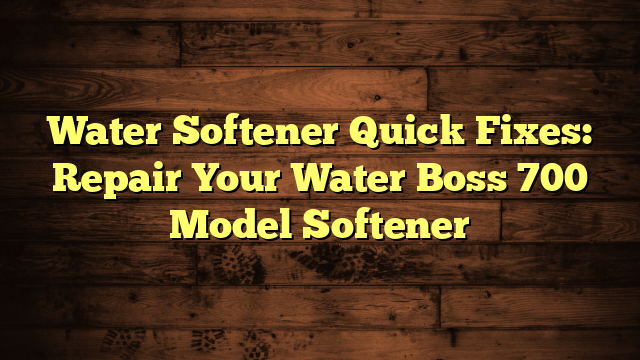Whats the Process of a Water Softner?
When you consider the process of a water softener, it's vital to understand how hard water affects your home and appliances. You might be surprised to learn that the core mechanism involves an ion exchange, where calcium and magnesium ions are swapped for sodium ions. But what happens when the resin becomes saturated? That's where the regeneration cycle comes into play. This cycle is fundamental for maintaining efficiency, but there are nuances you might not have thought about. So, what exactly does that regeneration entail, and why is it significant for your water quality?
Key Takeaways
- A water softener operates primarily through the ion exchange process, replacing hardness minerals like calcium and magnesium with sodium ions.
- Hard water passes through a resin tank filled with resin beads that attract and capture hardness ions.
- Once the resin beads become saturated with hardness ions, a regeneration cycle is initiated using a concentrated salt solution from the brine tank.
- The brine solution flushes out accumulated hardness minerals, restoring the resin beads' ability to soften water.
- Regular maintenance, including salt level checks and cleaning, is essential for optimal performance of the water softener.
Understanding Hard Water
When it comes to household water quality, understanding hard water is essential. Hard water contains elevated levels of minerals, primarily calcium and magnesium. These minerals contribute to water hardness, which can greatly impact your daily life.
You mightn't notice it at first, but hard water can lead to various issues in your plumbing and appliances. As you use hard water, mineral buildup occurs within pipes, faucets, and appliances like dishwashers and water heaters. This buildup can restrict water flow, reduce efficiency, and ultimately shorten the lifespan of these systems.
You may find yourself frequently descaling your fixtures, which can be both time-consuming and costly. In addition to affecting your plumbing, hard water can impact your laundry and bathing experiences. It can leave spots on dishes and make it difficult for soap to lather properly, leading to the need for additional detergent.
You may also notice that your skin feels dry and your hair lacks luster after washing. Understanding the implications of hard water helps you make informed decisions regarding your household's water treatment options, ensuring you maintain ideal water quality and prolong the life of your plumbing systems.
What Is a Water Softener?
How can you effectively combat the issues caused by hard water? A water softener is your solution. This device is designed to improve water quality by removing minerals like calcium and magnesium that contribute to hardness. By employing various softening methods, such as ion exchange or reverse osmosis, it enhances the effectiveness of soaps and detergents, leading to cleaner dishes, softer skin, and reduced scale buildup in plumbing.
Here's a quick overview of water softener types:
| Type | Description |
|---|---|
| Ion Exchange | Replaces calcium/magnesium with sodium |
| Reverse Osmosis | Filters out impurities through a membrane |
| Salt-Free Systems | Uses templates to prevent scale buildup |
| Magnetic Softener | Alters mineral structure without chemicals |
Investing in a water softener can greatly enhance your household's water quality. Its ability to soften water not only improves your day-to-day experiences but also protects your plumbing and appliances from the damaging effects of hard water. This means longer-lasting equipment and lower maintenance costs for you in the long run.
Key Components of Water Softeners
Key components of water softeners play an essential role in effectively reducing water hardness. The primary component is the resin tank, which contains resin beads that attract and remove hard minerals like calcium and magnesium from the water. This tank is vital for the softening process, as it serves as the site where the actual ion exchange occurs.
Another key component is the brine tank, which holds a salt solution used to recharge the resin beads. The brine solution helps restore the resin's effectiveness after it becomes saturated with hard minerals.
You'll also find a control valve that manages the flow of water through the system, ensuring efficient operation and timing of the regeneration process.
Additionally, many water softeners come equipped with a sediment filter, which removes larger particles from the water before it reaches the resin tank. This prolongs the life of the resin and improves overall system performance.
Together, these key components work harmoniously within a water softener to provide you with soft, high-quality water, protecting your plumbing and appliances from the damaging effects of hard water.
Ion Exchange Process
The ion exchange process is the heart of how water softeners function to reduce hardness in your water supply. This process involves replacing the calcium and magnesium ions, which cause hardness, with sodium ions.
When hard water passes through the resin beads in the softener, the negative charge of the resin attracts the positively charged calcium and magnesium ions. As these ions bind to the resin, sodium ions are released into the water.
The resin beads are specifically designed to hold a certain amount of sodium ions. As you use softened water, the concentration of calcium and magnesium ions increases on the resin, while the sodium ions decrease. This exchange continues until the resin becomes saturated with hardness ions, at which point it can no longer effectively soften the water.
During the ion exchange process, you may not notice a difference in water quality immediately, but over time, your plumbing and appliances will benefit from reduced scaling.
Ultimately, understanding this process helps you appreciate the technology behind water softeners and the importance of maintaining peak water quality in your home.
Regeneration Cycle Explained
After a certain amount of use, your water softener enters what's known as the regeneration cycle, an important process that restores the resin beads' ability to soften water.
This cycle typically occurs based on the regeneration frequency, which is determined by your water softener's settings and your household's water usage.
During regeneration, the softener flushes out the accumulated hardness minerals from the resin beads. This is achieved by using a concentrated salt solution, known as brine, which you add to the system.
The brine displaces the calcium and magnesium ions clinging to the resin, allowing them to wash away and be replaced by sodium ions from the salt.
The duration of the regeneration cycle varies, but it usually takes around 2 to 20 minutes.
It's important to monitor your salt consumption during this process, as an inadequate salt supply can hinder the effectiveness of regeneration.
Regularly checking your brine tank guarantees that your water softener operates efficiently and continues to provide you with soft water.
Understanding this cycle is vital for maintaining peak performance and extending the lifespan of your water softener.
Maintenance of Water Softeners
Maintaining your water softener is essential for guaranteeing its efficiency and longevity. Regular water softener maintenance helps prevent malfunctions and keeps your system running smoothly.
Start by performing routine inspections every few months. Check for any leaks, salt bridging, or sediment buildup in the brine tank. If you notice any issues, address them promptly to avoid further complications.
You should also monitor the salt levels in the brine tank. Ideally, you want to keep the salt level at least half full to guarantee efficient regeneration cycles. If you're using potassium chloride instead of salt, the same principle applies.
Periodically clean the brine tank and resin bed to remove any impurities that may hinder performance.
Another critical aspect of maintenance is checking the settings on your softener. Guarantee that the regeneration frequency is appropriate for your water quality and household usage. This may require adjustments based on changes in water hardness or consumption patterns.
Lastly, consult your manufacturer's guidelines for specific maintenance recommendations. Keeping up with these tasks won't only enhance the performance of your water softener but also extend its lifespan considerably.
Benefits of Softened Water
Softened water offers several advantages that can greatly enhance your daily life.
You'll notice improved skin health, as the absence of hard minerals reduces irritation and dryness.
Furthermore, your appliances will last longer and your laundry will come out cleaner and brighter without the interference of mineral buildup.
Improved Skin Health
When you switch to softened water, you'll likely notice significant improvements in your skin health. Hard water contains minerals like calcium and magnesium that can lead to dryness and irritation.
Softened water, on the other hand, enhances skin hydration, making it gentler on your skin.
Here are some benefits you may experience:
- Improved Skin Hydration: Softened water helps maintain moisture levels in your skin, preventing dryness and flakiness.
- Eczema Relief: For those struggling with eczema, softened water can alleviate symptoms by reducing irritation and promoting healing.
- Softer Skin: You'll find that your skin feels smoother and more supple, thanks to the absence of harsh minerals.
- Reduced Skin Irritation: Washing with softened water can minimize redness and irritation, particularly for sensitive skin types.
Enhanced Appliance Longevity
Over time, using softened water can greatly enhance the longevity of your household appliances. Hard water contains minerals like calcium and magnesium that can accumulate in your appliances, leading to scale buildup. This buildup reduces appliance efficiency by forcing them to work harder, resulting in higher energy consumption and potential breakdowns. By switching to softened water, you minimize mineral deposits, promoting smoother operation and reducing wear and tear.
Appliances like dishwashers, washing machines, and water heaters benefit greatly from softened water. You'll notice an increase in lifespan extension, as these appliances won't face the same level of stress caused by hard water.
For instance, your water heater can operate more efficiently without the insulating layer of scale, ensuring it heats water effectively and uses less energy.
Additionally, softened water leads to fewer service calls and repairs, saving you both time and money. You'll find that your appliances run longer and perform better, allowing you to enjoy peace of mind knowing that you're protecting your investment.
Better Laundry Results
Using softened water can greatly improve your laundry results, ensuring cleaner, brighter, and fresher clothes. When you wash your garments with softened water, you enhance the effectiveness of your laundry detergents, allowing them to perform at their best.
Hard water contains minerals that can hinder detergent performance, leading to dull colors and stiff fabrics.
Here are some key benefits of using softened water for laundry:
- Better Detergent Effectiveness: Softened water allows detergents to dissolve more easily, maximizing their cleaning power.
- Extended Fabric Life: Softer water contributes to better fabric care, reducing wear and tear on fibers during washing.
- Brighter Colors: Softened water helps maintain vibrant colors by preventing mineral buildup that can dull fabrics over time.
- Reduced Soap Scum: You'll notice less soap scum on your clothes and in your washing machine, leading to a more efficient wash cycle.
Common Misconceptions About Softening
You might believe that hard water isn't harmful or that water softeners require constant, complicated maintenance.
In reality, many misconceptions about hard water's effects and the simplicity of softener upkeep can lead to poor decision-making.
Understanding the facts can help you make informed choices about your water treatment options.
Hard Water Myths
While many people believe that softening water markedly alters its essential qualities, several common misconceptions persist about the hard water softening process. Understanding these myths can help you make informed decisions about your water quality.
- Soft water is chemically different from hard water. In reality, soft water is simply hard water with reduced calcium and magnesium ions.
- Softened water is unhealthy for drinking. Soft water is safe for consumption; however, if you're on a low-sodium diet, consult a doctor.
- Water softeners eliminate all impurities. Softening primarily targets hardness minerals; other contaminants like bacteria and heavy metals may still be present.
- Soft water causes plumbing issues. Softened water can actually help prevent scale buildup, leading to better plumbing performance.
Softener Maintenance Misunderstandings
Maintaining a water softener is vital for its efficiency and longevity, yet several misconceptions cloud the understanding of proper care. One common softener myth is that once you install a softener, it requires no further attention. In reality, regular maintenance is essential. You should check the salt levels monthly and refill as needed, as low salt can lead to inefficiency.
Another misconception is that all softeners require the same type of salt. Different units may work better with specific salts—be sure to consult your manufacturer's guidelines for the best results.
Moreover, some people believe that softeners need to be cleaned only when they malfunction. In fact, routine cleaning can prevent issues and guarantee peak performance.
You might also think that water softeners are maintenance-free devices. This isn't true; they require periodic regeneration cycles to function correctly. A good maintenance tip is to set reminders for these cycles based on your water usage.
Frequently Asked Questions
How Much Does a Water Softener Typically Cost?
A water softener typically costs between $400 and $2,500, depending on the model and capacity. For accurate cost comparison, consider installation fees and maintenance, ensuring you've budgeted appropriately for your specific needs.
Can I Install a Water Softener Myself?
Yes, you can install a water softener yourself with some basic plumbing skills. DIY installation saves costs and allows you to enjoy water softener benefits like reduced scale buildup and improved appliance efficiency.
How Long Do Water Softeners Last?
Water softeners typically have an average lifespan of 10 to 15 years. To maximize longevity, follow maintenance tips like regular salt refills, cleaning the resin tank, and monitoring system performance for peak efficiency.
Do Water Softeners Waste a Lot of Water?
You might be surprised to learn that water softeners can have efficiency concerns. While they do use some water during regeneration, the overall water usage is generally minimal compared to the benefits of softened water.
Are There Any Health Risks Associated With Softened Water?
Softened water generally poses no significant health risks; in fact, it often has health benefits, like improved skin hydration. However, if you're on a sodium-restricted diet, you should monitor sodium levels in softened water.
Conclusion
To sum up, while you might think a water softener's sole purpose is to pamper your plumbing, it's really a savvy little system that swaps out pesky minerals for sodium, leaving your water as soft as a cloud. Sure, you could embrace hard water's rugged charm, but why suffer through chalky deposits and dull appliances? After all, who wouldn't want their dishes sparkling and their skin feeling like silk? It's a modern miracle—if only your laundry could learn to appreciate it too.







